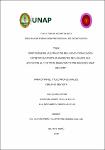Efectividad en la estimación de la edad cronológica entre dos métodos en pacientes de 5-10 años que acudieron al centro de diagnóstico por imágenes UNAP 2018 - 2019

View/
Date
2020Author
Padilla Tafur, Jeniffer Jazmín
Rodríguez Ruiz, Lila Margarita
Metadata
Show full item recordAbstract
La presente investigación tuvo como objetivo determinar la efectividad en la estimación de la edad cronológica entre dos métodos en pacientes de 5 - 10 años que acudieron al Centro de Diagnóstico por Imágenes UNAP 2018-2019. La población y muestra estuvo conformada por 419 radiografías panorámicas digitales. La investigación fue de tipo cuantitativo, diseño no experimental, comparativo, retrospectivo, transversal. La hipótesis de estudio es que ambos métodos, Demirjian y Nolla, son efectivos para la estimación de la edad cronológica en pacientes de 5 - 10 años. Se utilizaron la prueba no paramétrica W de Wilcoxon y la prueba paramétrica t de Student obteniendo los siguientes resultados: Con el método de Demirjian no se encontró diferencia significativa en el grupo etario de 5 a 5,99 (p-valor = 0,635), así como en el grupo etario de 7 a 7,99 (p-valor = 0,075), mientras que con el método de Nolla no se encontró diferencia significativa en el grupo etario de 5 a 5,99 (p-valor = 0,290). Se llegó a la conclusión que, ambos métodos son efectivos en un grupo etario, sin embargo, Demirjian demostró mayor efectividad en más de un grupo etario. The present research aimed to determine the effectiveness in estimating the chronological age between two methods in patients aged 5-10 years who attended the 2018-2019 UNAP Imaging Center. The population and sample consisted of 419 digital panoramic radiographs. The research was quantitative, non-experimental, comparative, retrospective, cross-sectional design. The study hypothesis is that both methods, Demirjian and Nolla, are effective for estimating chronological age in patients 5-10 years. The nonparametric Wilcoxon W test and the parametric T Student were used, obtaining the following results: With the Demirjian method, no significant difference was found in the age group from 5 to 5.99 (p-value = 0.635), as well as in the age group from 7 to 7.99 (p-value = 0.075), while with the Nolla method no significant difference was found in the age group from 5 to 5.99 (p-value = 0.290). It was concluded that the estimation of age by the Demirjian method is effective in two age groups: 5 to 5.99 years and 7 to 7.99 years, while the Nolla method only demonstrated effectiveness in the age group from 5 to 5.99 years. Thus demonstrating that Demirjian's method is more effective because it presents more age groups with less significant difference.
Collections
- Tesis [188]

